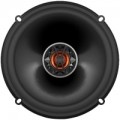—
Broadband speakers. The simplest type of acoustics: one speaker is used to reproduce the entire frequency range. The advantages of such speakers are simplicity of design (as a result, low cost) and ease of installation. On the other hand, the sound quality of full range speakers is significantly lower than that of dedicated speakers (see below).
—
Component speakers. The most advanced type of car speaker: it has separate speakers for each frequency band (see "Number of bands"), which allows you to customize the sound of each speaker as you wish and provide high sound quality. If the latter is the main factor for you when choosing car audio, you should pay attention to component speakers. However such systems are not cheap, and their installation can be quite complicated due to the large number of speakers.
—
Coaxial speakers. A kind of compromise between component and full-range speakers: in such systems, small-sized tweeters and mid-range speakers are placed directly in front of the larger woofer cone, on the same axis with it. This design simplifies installation, reduces cost, and delivers better sound quality than full-range speakers. However this quality is still lower than that of component systems, and therefore “coaxials” are usually used either as rear speakers, or when for some reason (for example, due to cramped conditions) it is impossible to install a
...component speaker.
— Cabinet speaker. The speakers of such acoustic systems are housed in a separate cabinet(s). This greatly simplifies installation — you do not have to find speakers to fit existing niches or even cut these niches on purpose, as in other types of speakers. On the other hand, such acoustics take up more space in the cabin.
— Midrange speakers. As the name implies, such a speaker reproduces only the middle frequency band, "cutting off" the highest and lowest. Technically, it can be used as a separate speaker, but this is usually not justified. Therefore, in fact, mid-frequency acoustics are usually installed as part of a more advanced component-type system (see above).
— Twitter. A speaker designed to reproduce high frequencies. Due to specialization, it is not used separately, it is used in combination with a mid-frequency speaker to build component-type systems (see above).The mounting depth of car audio is, in fact, the size of the speaker in depth. Note that for component sets (see "Type") this parameter is given for the largest speaker, and for case models it is generally irrelevant.
The mounting depth, along with the diameter of the speaker (see above), determines the amount of space needed to mount the speaker — in this case, how deep a niche would be required for normal mounting. At the same time, the larger the speaker, the larger, usually, the installation depth. And with similar diameters of equal size, a more powerful model is likely to be more “deep”.
The smallest amount of space —
up to 15 mm deep — is required by some tweeters. A depth
of 16 – 30mm is normal for tweeters and very shallow for general range speakers, most of these models have a depth
of 30mm or more. At the same time, full-range speakers are usually "recessed" by
less than 60 mm, component systems — by
less than 90 mm, and
more depth may be required only for some coaxial and mid-range models and, oddly enough, tweeters.

